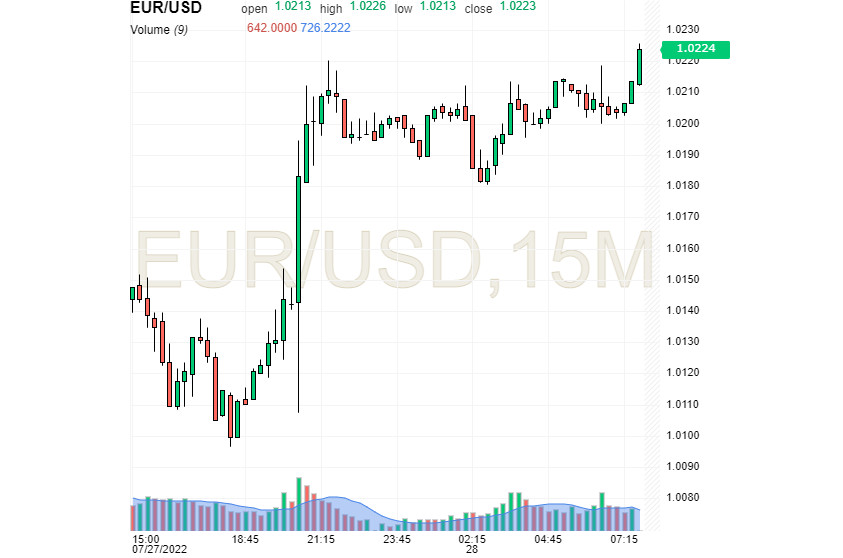
The US currency retreated from its leading positions after the Federal Reserve's decision to lower the federal funds rate by 0.75%. This worried the markets a bit, which put the greenback's rise in the prices. The influence of the "magic" bet has confused all the cards for traders and investors.
On Wednesday evening, July 27, the Fed expectedly raised the federal funds rate by 0.75%, to 2.25-2.50% per annum. According to analysts, this is the first increase in the interest rate by 0.75% in two consecutive meetings, recorded since the early 1980s. Note that market prices take into account the growth of futures on the federal funds rate to 3.40% until the end of 2022. At the same time, by the end of 2023, it is expected to decrease to 2.88%, experts emphasize. Market participants and analysts allow a 0.50% interest rate hike at the Fed's September meeting, citing the central bank's statements about the advisability of such a move.
Against this background, the European currency picked up speed, rising sharply against the dollar. The EUR/USD pair was trading near 1.0224 Thursday morning, July 28. However, the greenback is in no hurry to give up its positions and is looking for an opportunity for further growth.

The current actions of Fed Chairman Jerome Powell, which provided for a rate hike, temporarily pushed the dollar off its pedestal. In the evening, at a press conference, the head of the department said that the next rate hike would depend on current economic reports. At the same time, Powell does not exclude the possibility of raising the rate by a "large enough" 0.75% for the third time in a row.
Currently, the Fed is focused on the fight against off-scale inflation, which is constantly growing in general and base terms. As a result of the meeting, the central bank made it clear that the size of the Fed's steps on interest rates will slow down after it reaches a neutral level.
Earlier, currency strategists TD Securities released a baseline scenario, according to which the Fed after raising rates by 75 bp allows its further increase amid high inflation. At the same time, the Fed is ready for an accelerated rate hike, as economic growth remains strong. "This opens the door for another increase in September (by 75 bp)," TD Securities stressed. In the event of the implementation of the baseline scenario, the EUR/USD pair will trade near 1.0100, experts are certain.
According to experts, the increase in interest rates by the Fed has become the driver of the most powerful strengthening of the USD recorded over the past 20 years. This measure was required to curb the unprecedented inflation in the US. The Fed began tightening monetary policy a year ago, and in March 2022 began raising the discount rate. Against this background, the actions of the ECB ran counter to the strategy of the latter. The European regulator, seeking to support economic growth and mitigate the negative effects of the COVID-19 pandemic, has long been indecisive. As a result, the first increase in the key rate by the ECB (by 0.25 percentage points) took place only in July of this year.
Currently, two factors are pressing on the euro against the dollar: the tightening of the position of the US central bank and the threat of a recession in the European economy. The reason for the latter is a significant increase in energy prices. The current uncertainty and the danger of another cooling of the global economy encourage investors to flee from risky assets, primarily the euro, to a more reliable dollar. Against this background, the price of the latter is steadily growing.
The current energy crisis deprives Europe of an important competitive advantage - cheap energy, experts emphasize. This reduces the euro's chances for further growth. At the moment, the European currency is in a long-term downward trend against the US. At the same time, for several years the share of settlements in euros in world trade has been constantly increasing. However, now the situation is not in favor of the euro.
According to analysts at FCP Financial Management Ltd, the greenback will remain the leader of growth in the coming months. The fall of the US currency will begin in mid-2023, when the Fed will once again lower the interest rate. In the long term, the dynamics of the USD depends on the level of inflation in the United States, experts emphasize.
At present, when the market has priced in the entire key rate hike, the US central bank may soften its position, experts believe. This is possible in case of reaching the peak of US inflation. At the same time, the expectation of the easing of the Fed's position contributes to the reduction of credit spreads and puts pressure on the USD in the medium-term planning horizon.





















